Articles about the History of Belarus
General Information:
Major dates in the history of Belarus - here you can find
the most important facts in Belarusian history and become familiar with the key dates and
events by Aliaksandr Arciuhovich, on the basis of the J.Zaprudnik book "Belarus: At a
Crossroads in History".
History of Belarus - excerpts from
the book "Belarus - a new country in Eastern Europe", written in 1994 by
Uladzimir Novik, a member of the Belarusian Parliament. The book is written for foreign
readers who would like to familiarise themselves with Belarus.
Notes from the history of Belarus - if you
want to have a closer look at Belarusian history, this is a top opportunity. This pages
deal with the historical development starting from the first principalities on Belarusian
territory, the renaissance of Belarusian culture in the Middle Ages right down to the 20th
century (by E. Reshetau)
Songs
About Litwins from the Eldest Times to the year of 1434
(In Old Belarusian - Cyrillic
Win1251*)
A
Military History of Belarusian Lands Up to the End of Twelfth
Century By Jahor
Novikaǔ
XIII-XVII cc. The Grand Duchy of Litva - a medieval Belarusian state. Belarusian
Renaissance. 
- The Origins of Grand Duchy of Litva (Lithuania)
These articles deal with the creation and the first rulers of one of the major European
powers in the 13th-16th century.
- Lithuanian Metrics
Lithuanian Metrics is a 556 volume archive of documents of the State Chancellery of the
Grand Duchy of Lithuania (GDL) which was under the personal control of the Chancellor of
the GDL. This archive contained originals and copies of all documents issued in a period
from 1386 to 1794 by the State Chancellery.
- Statutes of the Grand Duchy of Lithuania
The Statutes of the Grand Duchy of Lithuania were a great achievement of Belarusian
Law. They were written during the 16th century and are among first European constitutions
and Law codes. They have served later as an etalon to other European nations. The Statutes
of the Grand Duchy of Lithuania are considered to be one of the main treasures (in
addition to Lithuanian Metrics) of Belarusian, Lithuanian, and Polish culture.
- Famous Belarusian Military
Commanders and Engineers
- Belarusian Renaissance of XV-XVI centuries.
- Crisis of Christian Orthodoxy and Catholicism - Reformation and Counter-Reformation in Belarus
- "Patop" - Deluge - Russo-Polish War of
1654-1667 - "Thirteen Years' War"
In 1632 joint forces of GDL and Poland sent by
the King and Grand Duke Uladyslau surrounded, defeated and taken prisoners
Russian (Muscovy) army, in defense of Belarusian city of Smaliensk. Russians
(Muscovites) have summoned their courage to come back to Belarus only in 20
years, when Ukrainian Cossacks of Chmielnicki revolted against the
rule of the Grand Duchy of Lithuania and joined
their forces with Muscovites (tsar Aleksei Mikhajlovich) to perform the
bloodiest carnage in the history of Belarusian nation - Russian War of
1654-1667. Poland could not come to help to Lithuania because it was
fighting at this time Swedes and Germans (First
Northern War). Too many enemies attacked Poland and GDL
simultaneously to defend our lands successfully. And the carnage begun. By
estimates of Belarusian historians more than 50% of Belarusians died in this
war defending their multi-cultural land, protestant religion and the Western
civilized style of life. Many famous Belarusian nobility families perished
in their entirety. The material losses were also tremendous. For example
only 100 houses were left out of 1500 houses in the city of Polacak, 56 -
out of 982 in Vitebsk. Belarus has lost Smaliensk lands to Russia. Because
of the sea of the spilled blood in those years Belarusian historians refer
to these 13 years as "Patop" - the Flood, the
Deluge. The picture
below is ("The Return of the Cossacks" by
Jozef Brandt, 1894.
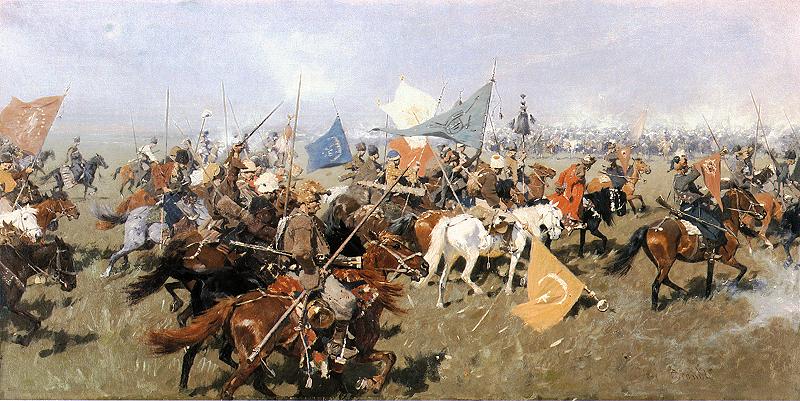
- "Paunochnaia Vajna" - Great Northern War or Second Northern
War
By the end of Second Northern War the region of Prussia, Poland and GDL
(Belarus and all Baltic states) was so demolished that for about 100 years
culture and civilization was pretty much suspended here. The normal history
was interrupted. In Belarus only 40% of agricultural lands were cultivated
because more 30% of population perished in Northern War, only one generation
apart from Russian War, that killed more than 50% of population.
XVIII c. "Rzecz Pospolita Polsko-Litewska" - Commonwealth
of the Kingdom of Poland and the Grand Duchy of Lithuania
- Three Partitions of Rzecz Pospolita Polsko-Litewska by Russia, Prussia and Austria:
1764, 1772, 1795.
- Tadeusz
Kosciszko and 1794 Uprising against occupation by Russian Empire
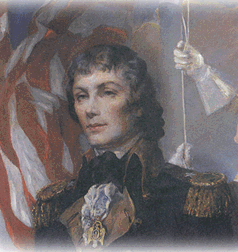
- Tadevush
Kasciushka - our own page in Great
Belarusian Military Commanders and Engineers series.
- The
1794 Uprising and T. Kasciushka at European History with Robert Wilde at About.com
-
More on the brutal suppression of 1794 uprising and Kosciuszko capture by Russians here at
Freemasonry site.
- Remarks at
Commemoration of General Kosciszko’s 257th Birth Anniversary by US
Ambassador in Belarus Michael Kosak:
"He fought for the freedom of the United States at a time when
his own country was not free. His strategic engineering genius was a
major factor in the first major victory of the American Revolution in
1777 at Saratoga. This triumph, viewed by most historians as the turning
point of the war, convinced France and other European powers to support
the American struggle for independence."
- Kosciuszko
bio at PolishWorld.com:
"From one man we can have but one life" - wrote about
Kosciuszko President Thomas Jefferson ' "and you gave us the most
valuable and active part of yours, and we are now enjoying and improving
its effects. Every sound American, sincere votary of freedom loves and
honors you..."
XIX c. Napoleon war. Belarusian revival. Belarusian Uprising of 1863-64.
- Napoleon War.
When the Great Army of Napoleon crossed the borders of Russian Empire and
attacked the Russian troops. Russians had to recede. On July 1 the
Napoleonic Army came to Vilna. The emperor created the government of the
Grand Duchy of Lithuania. Thus he attracted many local noble and
townspeople. 20 000 volunteers supported him with their wealth and guns.
Napoleon was cheered in Poland and Belarus as a liberator from Russians, who
could bring back Western influence in the region, abolish serfdom and free
people of other wild Russian Empire idiosyncrasies. Unfortunately, this did
not happen. Napoleon was defeated by the vastness of Russian territory and
the skill of Russian Field Marshal Kutuzov in the Battle of Borodino
near Moscow, Russia. Later defecting Napoleon Army had a crushing defeat in
the Battle on Biarezina in Belarus. The picture below was painted in 1843 by Peter von
Hess depicts Napoleon army crossing Biarezina river in Belarus, chased by
Russian Army.
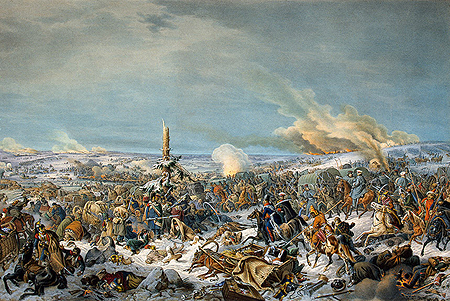
- New Belarusian Literature of XIX c. and Belarusian Cultural
Revival
In 1696 by decision of the Warsaw General Confederation, the Ruthenian (Old
Belarusian) language was replaced by Polish in all official documents of the
Grand Duchy of Lithuania. The Latin alphabet (Lacinka) replaced Cyrillic in
popular usage. Old Belarusian was still an official language of courts
proceedings in the former lands of the Grand Duchy of Lithuania until mid XVIII century, when it was
replaced by Polish and Russian. The bloodiest in the history of Belarus Russian/Ukrainian invasion of 1564-1567
followed by a prolonged Northern Wars with Sweden had completely destroyed culturally rich
Belarusian lands. Most of the cities were demolished. Our famous libraries
have been burned or robbed. Many countries in the Baltic region appeared in a similar
situation of destruction and complete stagnation that lasted for more than a
century. For half a century Be3larusian language was only surviving in
village household use. The first signs of recovery of Belarusian culture appeared only in
the beginning of the XIX century. A New Belarusian Poetry and Belarusian
cultural revival was announced by Jan
Chachot, Vincent
Dunin-Marcinkievich, Francishak
Bahushevich and their followers.
- Kastus' Kalinouski and
Belarusian Uprising of 1863-64 against Russian Empire.
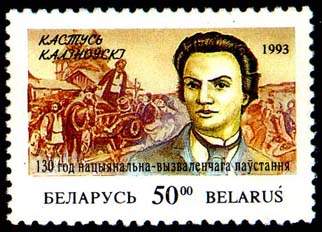
XX c. WWI, the end of Russian Empire, Belarusan Democratic
Republic.
- Belarus during the WWI
The WWI front was going straight through Belarus. My grandfather as a boy
was injured by German shrapnel in WWI. Tsar command center (Stavka) was in
Homel, Belarus.

- The
Belarusan Democratic Republic
The history of the first independent Belarusian state in
the 20th century (BDR, BNR in Belarusian). The Belarusian Democratic Republic came into being after the October
Revolution as a result of disintegration of the Russian Empire and
occupation of Belarusian lands by German army during WWI. After one year of
its existence (1918-119) it was pushed into an exile by the Bolsheviks,
advancing from East.
- Belarusan
Democratic Republic government in exile - their website is now
available on Internet
- Map of Belarusan Democratic
Republic, 1918
- About
national anthem of BNR - Vajacki marš
(Come, We Shall March In Joint Endeavour), Words
by: Makar Kraucov; Music by: Uladzimier Terauski. Download
lyrics and listen to music from original site or from our mirror (music
MIDI file, Lyrics in Belarusian
and English).
- BNR on Belarusian
Governments page of Belarus-Misc.org
- BNR
on Answers.com The Belarusian People's Republic was
pronounced on March 25, 1918 during World War I, when Belarus was
occupied by the Germans according to the Treaty
of Brest-Litovsk. In its Third Constituent Charter, the following
territories were claimed for BNR: Mogilev
guberniya
(province), parts of Minsk,
Hrodna
(including Białystok),
Vilnia,
Vitebsk,
and Smolensk
guberniyas, as well as parts of bordering guberniyas. The areas were
claimed because of a Belarusian majority according to demographic
research, although there were also numbers of Lithuanians,
Poles
and people speaking pidgins
of Belarusian,
Lithuanian
and Polish,
as well as many Jews,
mostly in towns and cities (in some towns they made up a majority). Some
of the Jews spoke Russian as their native tongue; others spoke Yiddish.
- BNR
on Wikipedia - due to the nature of Wikipedia (anyone can edit
information in it) it may be an alternative personal view on BNR.
- Belarus
1917-1922 at WHKMLA.
- V.
Zacharka
- P.
Krecheuski
- A. Ćvikievič
- Memorandum of the
Executive Council of the Rada of the Belarusian Democratic Republic In
Exile on 2006 presidential elections in Belarus.
- Latest news: Minister
of Estonia's Foreign Affairs Urmas Paet met Ivonka Survilla, the
President of the Rada of the Belarusian Democratic Republic in exile on
Thursday, 5 October, 2006
Soviet Belarus in 1919-1939. Belarus divided: BSSR and Western Belarus in Poland. 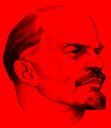
- Riga Treaty of 1920. Division of Belarus and Ukraine.
- BSSR - Byelorussian Soviet Socialist Republic.
January 1, 1919 - Proclamation (in Smolensk!) of the
Byelorussian Soviet Socialist Republic (BSSR) with its capital in Minsk.
Setting up of the Provisional Workers' and Peasants' Soviet Government
headed by D.Zhilunovich. Adoption of the first BSSR Constitution at the
first All-Byelorussian Congress of Soviets of Workers', Peasants' and Red
Army Deputies. The congress made an appeal to all the peoples on recognition
of independence of Belarus and establishment of diplomatic relations with
it. The BSSR Central Executive Committee (CEC) formed. The joint session of
the CEC of the Lithuanian SSR and the CEC of the BSSR in Vilnya decided to
create the Lithuanian-Byelorussian SSR that comprised the territories of
Minsk and Vilnya provinces.BSSR was part of the USSR until 1991, when
the USSR
was dismantled in the famous Belavezhskaia
Puscha meeting of three leaders: Gorbachev (Russai), Shushkevich
(Belarus) and Kravchuk (Ukraine). On the 27th of July, 1991 the
Supreme Soviet of the BSSR adopted the Declaration on State sovereignty of
the BSSR. On the 25th of August, 1991 the Supreme Soviet of the
BSSR suspended the Communist Party of Belarus. On the 19 August, 1991 the
BSSR was renamed to the Republic of Belarus. In December of 1991 the
Belavezh Accord on Denouncement of the 1922 Treaty resulted in the break-up
of the USSR. Belarus joined the Community of Independent States.
- Kurapaty - Stalin`s repressions in Belarus
Some information about the sad history of Belarus - the mass executions of innocent
Belarusians from 1937-41 and the repercussions of this policy up to the present day.
Including the article "Kurapaty - the Road of Death" by Z. Pazniak and J.
Smyhaliou . See also this article by Zyanom Pazniak "Physical Annihilation of Belarusian
Nation"
- 1939 Reunification of Western and Eastern Belarus.
1939-1945. World War II.
Below is the photo of downtown Minsk - Belarusian capital, that was
completely demolished in WWII by the bombings. The large building in the
distance is an Opera House.
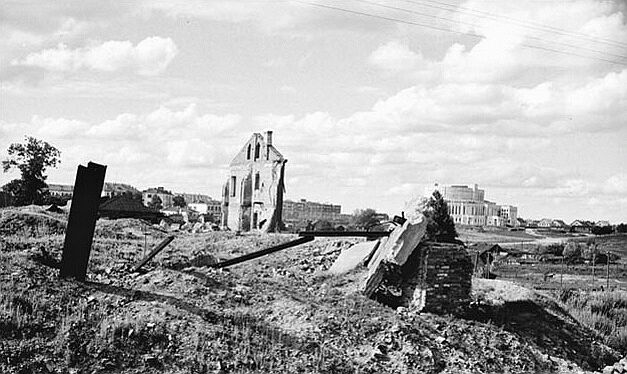
1946-1992. Post WWII Byelorussian Soviet Socialist Republic (BSSR).
1992-Present. The newly proclaimed independent state - Republic of Belarus.
Other Related Historical Topics.
Belarusian Heritage
Visit the
Belarusian Heritage Page 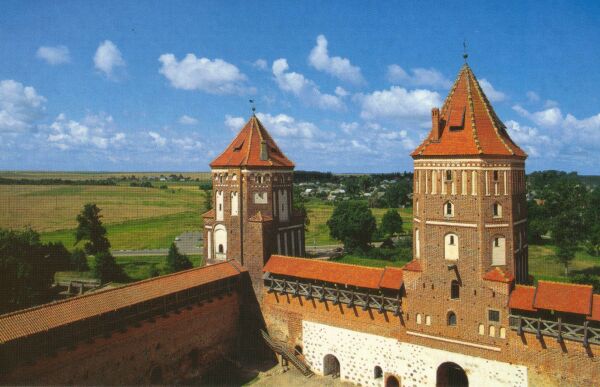
This project encompasses information about the historical and culutural Heritage of the
Belarusian people. It includes sites on various subjects compiled by the "Virtual
Guide"-time and links to other sources.
Here you can
... start on a journey through beautiful and historically
significant Belarusian towns and cities, learn about the history of more than 30 small
towns and large cities, see pictures of historical monuments - ancient churches, castles
and ruins - and landscapes - ranging from the lakes in the Braslau region in the North,
the hills of Navahradak down to the Palessie swamps in the South.
... On this journey through our country you will also learn
about famous representatives of our country across different centuries.
... moreover you can read about Belarusian architecture, traditional clothing,
crafts and more.
Historical maps of Belarus
Clickable historical map of Belarus
Slavic tribes - the Belarusians' ancestors - and their territories in the 9th - 12th c.
Map of principalities of Polacak, Turau, Navahradak
and Smaliensk - the first states on the territory of modern Belarus in the 9-11th cc.
(310 k)
Great Duchy of Litva (Lithuania) in the 13-15th cc. (220
k)
Great Duchy of Litva (Lithuania) in the 14-15th cc. (385
k)
The battle of Gruenewald on July, 15, 1410  Belarus at the end of the XVI c.:
Belarus at the end of the XVI c.:  Great Duchy of Litva (Lithuania) in the 17th c. (350
kB.)
Map showing towns in the Grand Duchy of Litva which
enjoyed home rule
War between Moscow and the GDL (1654-1667) (420
k)
Belarus in the middle of the XVIII c. (342k)
Great Duchy of Litva (Lithuania) in the 17th c. (350
kB.)
Map showing towns in the Grand Duchy of Litva which
enjoyed home rule
War between Moscow and the GDL (1654-1667) (420
k)
Belarus in the middle of the XVIII c. (342k)  Map of city of Slucak (Slutsk) in 1799 (129k)
Map of city of Slucak (Slutsk) in 1799 (129k)  War between Russia and Napoleon in 1812:
War between Russia and Napoleon in 1812:  Belarus at the end of the XIX c. (488k)
Belarus at the end of the XIX c. (488k)  Belarus in 1882
Fragment of an ethnographical map of the Slavic
world by Pr. Niederle, early 20th c. (164k)
Belarus in 1882
Fragment of an ethnographical map of the Slavic
world by Pr. Niederle, early 20th c. (164k)  Belarus in 1918-1920 - during German-Soviet and
Poland-Soviet wars (429 k)
Belarusian Democratic Republic in 1918 (195k)
Belarus in 1918-1920 - during German-Soviet and
Poland-Soviet wars (429 k)
Belarusian Democratic Republic in 1918 (195k)  Growth of the Belarusian Soviet Socialist Republic
(BSSR) in 1921-26 - transfer of territories with Belarusian population from Russia to
BSSR (within USSR) (240k)
Growth of the Belarusian Soviet Socialist Republic
(BSSR) in 1921-26 - transfer of territories with Belarusian population from Russia to
BSSR (within USSR) (240k)  West Belarus under Polish power in 1922-39
(352k)
West Belarus under Polish power in 1922-39
(352k)  Belarusian Soviet Socialist Republic in 1940 (580
k)
Belarus during the WWII:
Belarusian Soviet Socialist Republic in 1940 (580
k)
Belarus during the WWII:  Belarusians in north-east of Poland in 1993
(437k)
Belarusians in north-east of Poland in 1993
(437k)  The old map of Belarus and Litva (Lithuania) published with the permission of the
Russian Imperial Ministry of Internal Affairs in 1890:
Map of modern Belarus (185k)
The old map of Belarus and Litva (Lithuania) published with the permission of the
Russian Imperial Ministry of Internal Affairs in 1890:
Map of modern Belarus (185k)  Dialects on Belarusian territory (291k)
Dialects on Belarusian territory (291k)  The
map of Post Cold War Europe.
The
map of Post Cold War Europe.
Heraldry
Belarusian Heraldry - an overview of the historical
tradition of Belarusian Heraldry, including a large collection of the coats of arms of
Belarusian towns and cities.
Religion
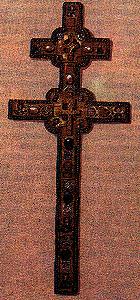
Religion in Belarus - short
account of Belarusian religious path
Belarusian Autocephalous Orthodox Church: A
Brief History - by D.Zielenka
Belarusian Icon-Painting - some
pictures of original school of sacral paintings by Mikalaj Karelin
Periodicals
Belarusian Historical Review -
new historical sources and materials, various articles on Belarusian history, essays on
historiography and other specific aspects of historical science
Other documents
 This file is a part of the Virtual
Guide to Belarus - a collaborative project of Belarusian
scientists and professionals abroad. VG brings you the most extensive
compilation of the information about Belarus on the Web.
This file is a part of the Virtual
Guide to Belarus - a collaborative project of Belarusian
scientists and professionals abroad. VG brings you the most extensive
compilation of the information about Belarus on the Web.
Please send your comments to the authors of VG to
Belarus 
History | Statehood | Culture | Law
and Politics | Cities | Nature and Geography | Travel | Global Resources | Dictionaries | Chernobyl | Genealogy | Industry | New
 VG to Belarus
VG to Belarus
Disclaimer











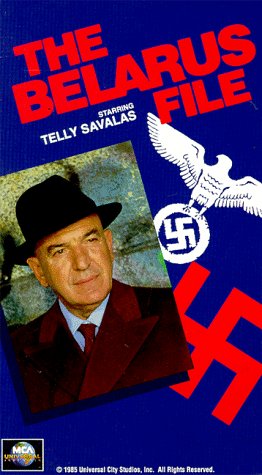


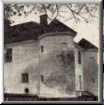 Belarusian
Castles
Belarusian
Castles  This file is a part of the Virtual
Guide to Belarus - a collaborative project of Belarusian
scientists and professionals abroad. VG brings you the most extensive
compilation of the information about Belarus on the Web.
This file is a part of the Virtual
Guide to Belarus - a collaborative project of Belarusian
scientists and professionals abroad. VG brings you the most extensive
compilation of the information about Belarus on the Web.